Industrial Fans
Below are six of the more popular design of industrial fans:
Axial-flow Fans
There are four types of axial-flow fans. Listed in the order of increasing static pressure,they are;
Propeller Fans
The propeller fan, sometimes called the panel fan, is the most commonly used of all fans. It can be found in industrial, commercial, institutional and residential applications. It can exhaust hot or contaminated air or corrosive gases from factories, welding shops, foundries, furnace rooms, laboratories, laundries, stores or residential attics or windows.
Sometimes several propeller fans are installed in the walls of a building, operating in parallel and exhausting the air, towards the ceiling where the hot air is located.
Belt driven, electric motor fans consist of the following 11 components: a spun venturi housing, a bearing base (plus braces), two bearings, a shaft, a motor base, an electric motor, two pulleys, a belt and a fan wheel. Having the motor located opposite the rotating fan blades results in good motor cooling but some obstruction to the airflow.
A simpler configuration of a propeller fan with direct drive from an electric motor is possible. This unit consists of just 4 components: a spun venturi housing, a motor base (plus braces), an electric motor and a four-bladed fan wheel.
The belt-drive arrangement has the following three advantages:
1. It results in flexibility of performances, since any speed (rpms) can be obtained for the fan wheel by selection of the proper pulley ratio. However, when the speed is increased to boost the flow (cfm), the brake horsepower will increase even more, as the third power of the rpm ratio, as will be explained later.
2. In large sizes, belt drive is preferable, since it will keep the speed of the fan wheel low or moderate while keeping the motor speed high, for lowest cost. (High-speed motors are less expensive than low-speed motors of the same horsepower.)
3. The motor will get good cooling from the air stream passing over it.
The direct-drive arrangement has the following five advantages:
1. It has a lower number of components, resulting in lower cost.
2. It requires no maintenance and regular checkups for adjustment of the belt.
3. It has a better fan efficiency, since a belt drive would consume an extra 10 to 15 percent of the brake horsepower.
4. It results in more flow (cfm) because the central location of the motor does not obstruct the airflow.
5. The performance flexibility of the belt-drive arrangement also can be obtained, but at an extra cost, by means of adjustable-pitch blades and by a variation in the number of blades. A 3 degree increase in the blade angle will result in a 10 to 15 percent increase in flow (15 percent in the range of small blade angles, 10 percent for larger blade angles). The static pressure can be boosted by an increase in the number of blades, up to a point.
Conclusion: Direct drive is less expensive and more efficient. It is preferable in small sizes. Belt drive is preferable in large sizes and results in better performance flexibility than direct drive, unless adjustable-pitch blades are used.
Most propeller-fan wheels have sheet metal blades riveted to a so-called spider. This is a lightweight, lower-cost construction that is somewhat less efficient but adequate in small and medium sizes. Many propeller-fan wheels are plastic molds. In very small sizes, where cost is more important than efficiency, one-piece stampings are sometimes used.
Shutters
Most propeller fans are used for exhausting from a space. They are mounted on the inside of a building, with the motor located on the inlet side, inside the building and the air stream blowing outward. A shutter is mounted on the outside. There are two types of shutters: Automatic shutters and motorised shutters.
For example, an automatic shutter with three shutter blades linked together and mounted on hinged rods. The shutter will be opened by the air stream on start-up of the fan. It will be closed by the weight of the shutter blades when the fan is turned off. The motorised shutter, used mainly in larger sizes, is opened and closed by a separate small motor mounted on the shutter frame. When the shutter is closed, it will prevent heat losses due to backdraft and keep out wind, rain and snow.
Screen Guards
Sometimes a fan guard is fitted over the motor side of a propeller fan for safety, whenever the fan is installed less than 7ft from the floor.
It uses a steel mesh, designed for minimum interference with the air stream.
Man Coolers
Another application for propeller fans (besides exhausting from a space) is for cooling people (as the term man coolers implies) or products or for supplying cool air to certain processes. These cooling fans are located in hot places, such as steel mills, foundries and forge plants. They are also used for cooling down furnaces for maintenance work, for cooling electrical equipment (such as transformers, circuit breaker and control panels, or for drying chemical coatings.
Man coolers can be mounted on a heavy pedestal for stability. It has a lug on top so that it can be moved easily to various locations. It has a 30-in propeller-fan wheel with six narrow blades and direct drive from a 3-hp, 1740-rpm motor.
Other man coolers can be wall mounted using a bracket, up high enough so that it cannot be damaged by trucks and the wires cannot be cut by wheels. As a special feature, this unit has a conical discharge nozzle that boosts the outlet velocity for deeper penetration. The nozzle contains some straightening vanes, almost like a vaneaxial fane, to prevent excessive air spin at the narrow end of the cone.
Tubeaxial Fans
The best application for tubeaxial fans is for exhausting from an inlet duct. A short outlet duct can be tolerated, but the friction loss there will be larger than normal because of the air spin. If no inlet duct is used, a venturi inlet is needed prevent a 10 to 15 percent loss in flow and an increased noise level. In the case of belt drive, the motor is located outside the cylindrical housing and a belt guard is needed. Direct drive has fewer parts and therefore lower cost, the same as for propeller fans and the performance flexibility again can be obtained by means of adjustable-pitch blades.
Vaneaxial Fans
A vaneaxial fan can be belt driven from an electric motor, although direct drive is simpler and less expensive. Also, performance flexibility for direct drive can be obtained by means of adjustable-pitch blades. Again, a venturi inlet is needed if no inlet duct is used.
Two-stage Axial-flow fans
Two-stage axial-flow fans have the configuration of two fans in series so that the pressures will add up. This is an easy solution when higher static pressures are needed, but excessive tip speeds and noise levels cannot be tolerated. The two fan wheels may rotate in the same direction, with guide vanes between them. Or they may be counter rotating, without any guide vanes.
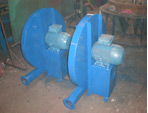 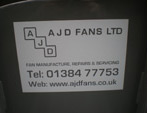 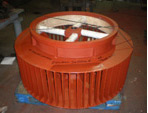 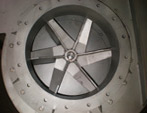 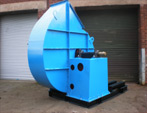
|